Films: Beyond Bollywood--in New York
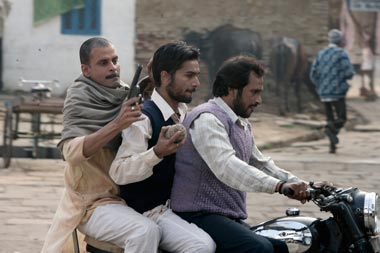
Festival celebrates indie and alternative Indian cinema with several gems, original and creative storylines, and a trend suggesting that young Indian-American filmmakers seem to have finally put their angst about their cultural roots aside and moved past Americanness versus Indianness to more demanding subjects.
A scene from Anurag Kashyap’s “Gangs of Wasseypur,” the gritty and massive 5 hours 20 minutes film with which the festival concluded. (Photos: Michael Toolan.)
They may never meet them in the flesh, yet they know the superstar Khans—SRK, Salman, and Amir—almost better than they know themselves. They may never board a plane, yet they travel from Australia to Spain to Switzerland via the lush locations seen in Hindi blockbusters. And they may never wear stylish clothes, yet they know all about the latest fashions from the endless wardrobe changes that Kareena Kapoor or Priyanka Chopra undertake per song sequence.
Yes, no doubt about it—Indian moviegoers have grown up on a steady diet of Bollywood films!
Yet there’s much more to Indian cinema than the predictable storylines, musicals, and colorful item numbers of Bollywood, and a rapidly growing fan base is flocking to the offbeat and the unusual, the independent and the quirky. The recent New York Indian Film Festival (NYIFF) showed a good mix of all that is happening in alternative cinema, appropriately enough in the 100th year of the film industry.
Indeed, if filmdom’s pioneers had been around, they would have been quite pleased with the diversity at the NYIFF. Now in its 12th year and the oldest Indian film festival in America, it is organized by the Indo-American Arts Council (IAAC), headed by Aroon Shivdasani, with Aseem Chhabra serving as director of the festival, and a programming committee selecting the films.
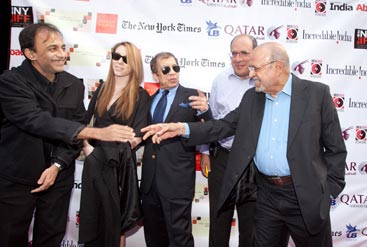
Suneil Anand, son of thespian Dev Anand, greets acclaimed director Shyam Benegal, who was honored with a Lifetime Achievement Award at the Festival.
The festival showcased over 44 films—and not a single Bollywood film, except for a tribute to Dev Anand with a showing of the colorized version of Hum Dono. The festival had its share of red carpet glamour, parties and after parties, as well as panel discussions and Q and A’s with directors and actors, including the iconic Shyam Benegal, who was honored with a lifetime achievement award and a retrospective of the trilogy: Mammo, Zubeida and Sardari Begum—the complete antidote to Bollywood.
One could say the festival spotlighted some of the emerging trends in cinema as well as the changing tastes of diaspora audiences. Earlier it was believed that only a big Bollywood melodrama with big names and big music would draw in the crowds. The festival had no big Bollywood offerings nor big stars—yet the film buffs turned out for independent films, art house movies, regional cinema, and documentaries, as well as to meet innovative filmmakers and actors.
The good news for non-Hindi speaking audiences is that Tamil, Bengali, Marathi and other regional films were highlighted. The festival showed Rituparno Ghosh’s Chitrangada as its centerpiece film and included several regional films, including Aadukalam, Shala, Aashpordha and Abosheshey. Subtitles in English are the great equalizer, opening up new worlds and unfamiliar tongues to both Indian and non-Indian audiences alike. It is quite affirming to find the common humanity in so many different lives.
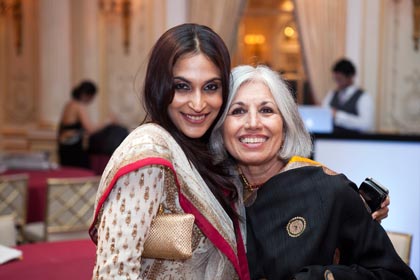
Aishwarya Rajnikanth Dhanush, who made her directorial debut at the festival with 3, with Aroon Shivdasani, executive director of NYIFF.
A well-known celebrity from the South, Aishwarya Rajnikanth Dhanush, made her directorial debut at the festival with 3. The daughter of Rajnikanth and wife of Dhanush, she is a noted classical dancer. In this Tamil film, starring Dhanush and Shruti Haasan, she undertook the difficult subject of mental illness.
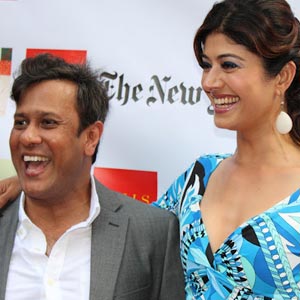
Bedabrata Pain, a research scientist who left NASA to pursue filmmaking, with actress Pooja Batra.
The festival showcased the work of many first-time directors, underscoring that the love of cinema is embedded in the genes of Indians, both in India and the diaspora. The opening night film was the very powerful Chittagong by first-time filmmaker Bedabrata Pain, a research scientist who left NASA to pursue filmmaking. Pain, who was the producer of the national award-winning Amu directed by his wife Shonali Bose, directed Chittagong with a deft hand. It follows untrained teen-aged revolutionaries, led by a schoolteacher in a daring revolt against the British.
New directors are certainly going on their own paths, taking on difficult issues. Perhaps the most impudent and enjoyable is Kumare, directed by Indian-American filmmaker and self-proclaimed religious skeptic Vikram Gandhi. In the film, he transforms himself into an Indian guru—and like sheep, the believers follow him! This real documentary about a fake guru, which won the Audience Award for best documentary at the 2011 SXSW Film Festival, tells us a lot about human nature and the power of belief.
Young Indian-American filmmakers seem to have finally put their angst about their cultural roots aside and moved past Americanness versus Indianness to more demanding subjects. Some of the Indian-Americans who showcased their work at this festival include Mukesh Vidyasagar, whose film Silent Water creates awareness about clean water and raises funds for Gramalaya, a non-profit in India; Anirban Roy of Los Angeles, whose film Aashpordha, about teenage rebellion in a middle-class family in Kolkata, has been picked up for national telecast by SBS Australia; and Mridu Chandra of New York, who has produced award-winning films such as Himalaya Song, which showed at the 2012 Sundance Film Festival. Chandra’s new film Indian Summer follows Indian-American children at the Hindu Heritage Summer Camp in Rochester, NY.
Many emerging filmmakers are starting out with short films and going the film festival route. Vishesh Sharma, who moved to the US only in 2000, has just finished directing his first short film Color of Anger. Other shorts include Vivek Sharma’s 14-minute film The Plan and Kabir Chopra’s Strangers.
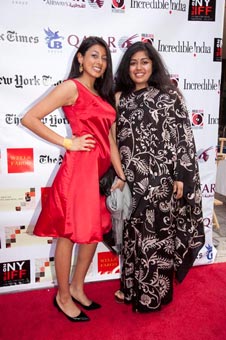
Lipica Shah and Bornila Chatterjee, whose film, Let’s Be Out, the Sun is Shining, won the Audience Choice Award.
In many of the films, the protagonists are of Indian origin but their Indianness is not crucial to the story. Take the film Let’s Be Out, the Sun is Shining, made by Bornila Chatterjee, who was born in Los Angeles and grew up in Calcutta. She worked in theater in India and returned to the U.S. graduating from NYU’s Tisch School of the Arts. Her first feature film, Let’s be Out is a truly American story about finding oneself, and it ended up winning the Audience Choice Award at the festival.
Documentaries and improvised filmmaking techniques in feature films also seem to be a trend. The festival had some thought-provoking documentaries and shorts including Inshallah Football, Kumare, Big in Bollywood and Transgenders: Pakistan’s Open Secret. The film Saving Face, about acid violence victims in Pakistan, which had won an Oscar for Daniel Junge and Sharmeen Obaid-Chinoy, bagged the documentary award at this festival, too.
Rather than feel-good, candy romances, many filmmakers seemed to search for deeper elements and complex issues, often using children and teens as their protagonists to address deeper issues. There were so many good performances by young actors in several films that a special Young Actor Award was added, going to Mohammad Samad for Guttu.
The global village feel has come to the world of cinema, too—movies are often being released on the same day in major cities, and Indian audiences are getting to share the best of world cinema. Emerging Indian-American filmmakers are also inspired by the work of filmmakers of the diaspora like Mira Nair, Gurinder Chadha, Deepa Mehta, M. Night Shyamalan and Nagesh Kukunoor. A touch of Bollywood influence is always there, but the genres and techniques are varied.
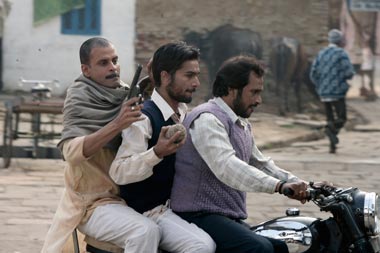
A scene from Anurag Kashyap’s “Gangs of Wasseypur,” the gritty and massive 5 hours 20 minutes film with which the festival concluded.
One great example of how individual directors are transforming Indian cinema was Anurag Kashyap’s Gangs of Wasseypur, which was the closing film of the festival and created a lot of buzz. The film came fresh from its premiere at Cannes, where this massive 5 hours 20 minutes film with 25 songs was shown in its entirety! The length of Indian movies and the many songs had always been a no-no for Western audiences, but at Cannes, presented in Kashyap’s gritty style, they lapped it up.
“Music is a very universal thing. Everyone loves music,” Kashyap told me in an interview. “The problem with Bollywood has been that actors suddenly start singing and dancing. We’ve used songs in the background and that’s probably more relatable.”
Indeed, perhaps the single biggest difference between Bollywood films and the other genre of films is the realism factor—or the lack thereof. As Kashyap pointed out, Bollywood cinema throws logic to the winds. “Realism is the first main ingredient of cinema.There first has to be realism. Hindi films are very fake.” He actually feels Indian cinema has regressed in this 100th year, as compared to the films of the ‘50s and ‘60s. “We were much more progressive, less moralistic, and we were more daring than we are now.”
The new crop of un-Bollywood films, shorts and documentaries may just be the ones to inject these lost qualities into Indian cinema.
[Lavina Melwani is a New York-based journalist for several international publications and blogs at www.lassiwithlavina.com.]
| The winners of the NYIFF 2012 Jury Awards Best Film: Gattu by Rajan Khosa Best Director: Sujay Dahake for Shala Best Actress: Tannishtha Chatterjee for Dekh Indian Circus Best Actor: Nawazuddin Siddiqui for Dekh Indian Circus Best Young Actor Award: Mohammad Samad for Gattu Audience Choice Award: Let’s Be Out, The Sun is Shining by Bornila Chatterjee Best Short Film Award: Bombay Snow by Chinmay Dalvi Best Documentary: Saving Face by Daniel Junge and Sharmeen Obaid-Chinoy (also won the Oscar for Best Doc) Best Screenplay: Avinash Deshpande for Shala Special Contribution to Indian Cinema Award: actor/director Rituparno Ghosh Lifetime Achievement Award: director Shyam Benegal |
Enjoyed reading Khabar magazine? Subscribe to Khabar and get a full digital copy of this Indian-American community magazine.
blog comments powered by Disqus












